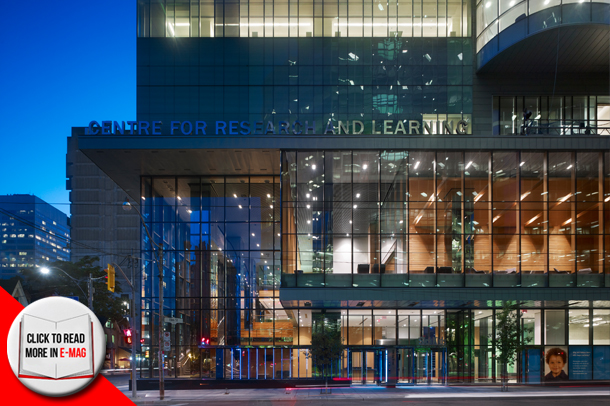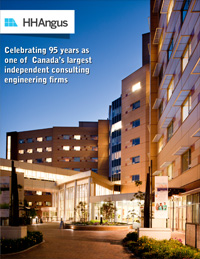Celebrating 95 years as one of Canada’s largest independent consulting engineering firms.
By Leah Kellar
2014 marks 95 years of firsts, in Canada and internationally, for the award-winning firm of HH Angus and Associates Ltd. — from its early days engineering the rudimentary beginnings of electricity use to being among the first in the industry to design sustainable buildings, well before it was standard practice.
HH Angus engineered the first district heating system in Canada in the 1960s, now known as EnWave The firm designed and engineered the mechanical and electrical elements for the first skyscraper in Canada (Cadillac Fairview’s TD Tower in Toronto), completed in 1967. The skyscraper was one of HH Angus’ first iconic commercial projects. Another landmark project was Canada’s first sports stadium with a fully retractable motorized roof—Toronto’s SkyDome opened in 1989, and is now known as Rogers Centre. HH Angus also led the way in sustainable design and building as early as the 1980s when it incorporated solar panels and geothermal systems.
Today, the firm remains at the forefront of design through leading edge technology, standards and practices, as it has done for more than half a century. HH Angus provides mechanical and electrical consulting engineering services to a broad range of clients in the healthcare, technology, commercial and energy sectors. Technical skills are offered across the entire spectrum of mechanical and electrical engineering for the built environment, as well as commissioning, communications and security, IM/IT, simulation, sustainability, vertical transportation, lighting design, and ICAT (Information and Communications Automation Technology).
HH Angus was the first to introduce 100 per cent fresh air flow for a healthcare facility, for which HH Angus was awarded a Consulting Engineers of Ontario Award of Merit. North Bay Regional Healthcare Centre in Ontario was the recipient of this innovative design that reduces exposure to airborne contaminants. This is just one example of how HH Angus is continuing its pioneering tradition in leading innovation.
Another is British Columbia’s Royal Jubilee Hospital’s Patient Care Centre, which was the first hospital to receive LEED Gold certification for a high performance building that is both sustainable and green. HH Angus provided all mechanical and electrical consulting engineering, plus security design, IMIT engineering, vertical transportation and lighting design for this state-of-the-art 400,000 square foot, 500-bed acute care and psychiatric facility.
These examples are only a few in a long list firsts for a company that continues to elevate standards of sustainability in the industry, and change the Canadian skyline, since Harry Holborn Angus first opened his mechanical engineering firm in 1919.
“We’ve always expanded when the market needed us to expand into different areas of specialization,” said Barbara Bradley, Vice President of Marketing and Business Development, in a recent interview with Business Elite Canada.
Bradley, who has been with HH Angus for four years, graduated with a degree in design and business. She worked for some of the major furniture manufacturers before entering into a national business development role at Stantec prior to joining HH Angus.
Her colleague, Tom Halpenny, Vice President of Operations, also spoke about the roots of HH Angus as an emerging icon in the consulting engineering industry.
“In the early times of HH Angus, we worked mostly in and around Toronto, as well as a lot of work for Canadian Forces bases. Today, we’re still headquartered in Toronto, but our work takes us across Canada and around the globe; for example, we worked extensively the UK, particularly at Canary Wharf and in healthcare facilities; we continue to work in the Middle East, as well as the Caribbean, and generally in any locale where our clients need us to be.”
Halpenny joined HH Angus after graduating in 1978. He started as a junior engineer and worked his way up to project manager, and then moved into management. Halpenny has witnessed the amazing growth of the company and the scale of its milestone projects.
The company grew slowly over the first half of the twentieth century. In 1946, it incorporated and offered mechanical and electrical engineering services. After founder Harry Holborn Angus passed, company leadership passed to his son, Donald L. Angus, and the company flourished under his leadership. This was after HH Angus helped to develop SAGE, NORAD’s Semi-Automatic Ground Environment to control its continental missile and radar detection systems in the event of a nuclear attack. This was the firm’s first computing centre job. In the 1970s, the firm branched into consulting to meet a growing client demand.
Donald’s son, Harry G. Angus, ushered in the third generation of successful management when he assumed the presidency in 1985. Since then, HH Angus has continued to pursue projects that exemplify raised standards in technical, green and sustainable innovations. Throughout the 1980s and 1990s, HH Angus worked on many international developments including Canary Wharf in London, England, and projects in China, the Middle East and Africa.
A variety of HH Angus’ innovative and iconic Canadian projects include:
- Toronto’s Sunnybrook Hospital which, in 1946, was the largest healthcare facility in the British Commonwealth.
- The University of Toronto’s Terrace Donnelly Centre for Cellular and Biomolecular Research, which was the first research centre in Canada to use a double façade ventilation system, featuring occupant-controlled motorized louvres and window blinds.
- Canada’s first combination MRI and Cardiac Catheterization lab at Sunnybrook Health Sciences Centre’s Imaging Research Centre for Cardiac Intervention in Toronto.
- Sir William Osler Hospital—Ontario’s first Hospital P3 Project.
- The first cogeneration energy plant for emergency power generator in Canada – an award-winning installation.
- The first large-scale interactive video wall for an operating room in Ontario at St. Joseph’s Healthcare in Hamilton and,
- The world’s first high-speed moving sidewalk at Lester B. Pearson International Airport in Toronto.
To add to this list, the firm is presently working in Montreal on what will be the largest hospital in North America. Occupying 2 ½ city blocks, the Centre Hospitalier de l’Université de Montréal will be a massive $2+ billion, 3,800,000 ft2 hospital, which HH Angus is designing in Revit©, a 3D modeling graphic software.
“The size and scope of this project have certainly raised our profile, due to its engineering complexity,” said Bradley.
More than 70 per cent of HH Angus’ portfolio is repeat business, and the company enjoys a long history of good relations with many major institutions and corporations in Canada. Their work with Sunnybrook Health Sciences Centre dates back to the mid 1940s. Other long time clients include Sick Kids Hospital, the University Hospital Network, St. Michael’s Hospital, Queen’s University in Kingston, the University of Toronto, the Toronto Dominion Bank, the Royal Bank of Canada, and, of course, its decades-long relationship with Cadillac Fairview, among many others. The firm attributes these important relationships to consistent service and successful outcomes that have helped HH Angus to win many important projects.
The firm’s 200 plus staff includes 50 licensed professional engineers and 50 employees who are LEED accredited professionals. Employee retention is a source of pride for the firm – more than 40% of employees have over 20 years of service with HH Angus.
”While we maintain project offices wherever necessary, generally speaking our highly experienced team works from our base in Toronto. This ensures our clients receive consistently high value, because our knowledge base remains centralized in one location,” said Halpenny.
HH Angus considers its technical strength in a broad range of building systems and infrastructure projects to be one of the biggest assets that has helped to set the company apart from its competition in recent years.
“We have several individuals working here who are the go-to people in the industry for technical help in their specialty,” said Halpenny.
In terms of the challenges the firm faces, Halpenny notes that the industry itself is evolving.
“We’ve seen a lot of acquisitions of engineering firms and technical firms, and everyone faces the same challenges, more or less, in terms of differentiating their service offerings and coming to the marketplace with new ideas.
“The speed at which the marketplace is changing is also challenging firms who work in the built environment. New approaches to design and construction are creating opportunities for those who are well positioned to take advantage of them; for example, the IT sector is growing rapidly. We recently identified a gap in service offerings in this area and have launched a business that helps clients strategically plan for the future of their facilities and their businesses. We’re very excited about the potential for growth in this area,” said Halpenny.
As they near a century of milestone projects, infrastructure renewal is a current focus for HH Angus; for example, the firm is working with Cadillac Fairview on ongoing infrastructure renewal for the Toronto Dominion Centre, a complex it engineered almost a half-century ago in the downtown core. New technologies and new environmental standards are driving renewal in many sectors.
“That is going to be the next industry challenge – – to bring all of these old buildings up to date,” said Halpenny.
And, in the spirit of sustainability, with 95 years of contributions to the Canadian infrastructure mosaic, what’s old is new again.







